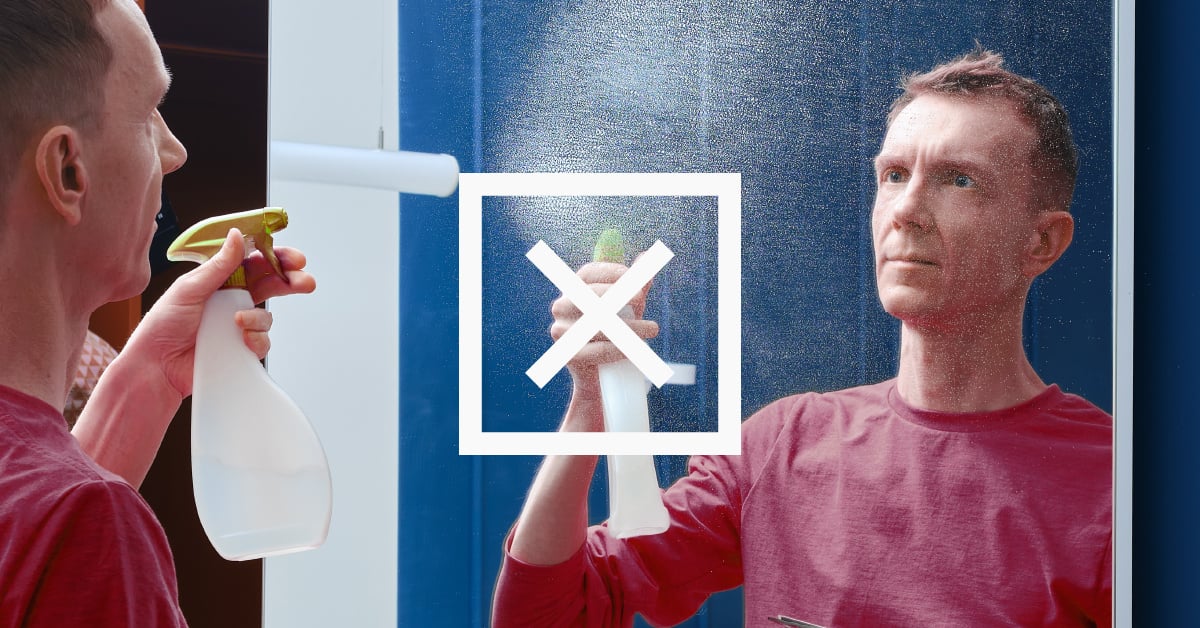Do your mirrors get black edges, scratches, or streaks? Then you're probably cleaning them incorrectly! Mirrors are far more delicate than countertops and tile, but people often use the same chemicals and techniques to clean them.
A good-quality mirror should last over 20 years if you clean it with care, using gentle products and a light touch. But if you've already noticed some light scratches, we also included a few DIY fixes you could try at home to save money!
Common Mirror-Cleaning Mistakes
Avoid these window cleaning no-nos to keep your mirrors scratch and streak-free:
- Scraping the surface with razor blades or other metal tools
- Applying cleaner directly to the mirror
- Pressing too hard
- Using inappropriate products, including CLR, Lime-Away, or ceramic tile cleaners
- Letting glass cleaner collect along the bottom edge
What Is the Best Way to Clean Mirrors?
Cleaning your mirrors without damaging them is pretty easy as long as you use the right products!
Here’s how to get a streak-free finish in four easy steps:
- If needed, remove any visible debris by dipping the corner of a soft cloth (preferably microfiber) in rubbing alcohol and gently scrubbing the affected area
- Apply a glass cleaner — like Windex or Sprayway — to the middle of the cloth
- Start cleaning a small area of the mirror using the middle of the cloth and gentle pressure
- Slowly clean the rest of your mirror, and use a new cloth and additional cleaner as needed
How to Clean Mirrors Naturally

If you prefer to use all-natural products to clean your mirrors, here are two recipes we love to use at home!
Basic Mirror Cleaning Spray
This basic recipe is cost-effective and gets the job done!
- ½ cup water (use distilled if you have hard water)
- ½ cup white vinegar
- 1 tablespoon cornstarch (optional)
The cornstarch helps remove light debris from the glass, but you can skip it or use the rubbing alcohol method we outlined above.
Streak-Free Mirror Cleaner
This DIY solution helps you achieve a streak-free finish quickly.
- ¼ cup vodka
- ¼ cup white vinegar
- 1 tablespoon cornstarch (optional)
- 2 cups warm water
Combine these ingredients in a spray bottle and shake well before using. When you're finished cleaning your mirrors, be sure to store the remainder in a cool, dark place.
Pro tip: If you’re cleaning larger bathroom mirrors, you might prefer the streak-free formula to help minimize drying time!
Additional Mirror Cleaning Tips
Got stains or small scratches? Try these solutions before you investigate more expensive fixes.
How to Clean Mirror Stains
Got a tough stain? If you’ve already tried a DIY or commercial glass cleaning product, your next step is to try a product containing cerium oxide. We find that CRL “Sparkle” Cleaner and Stain Remover works especially well.
How to Clean a Mirror That Is Hazy or Foggy
If one of your mirrors has become hazy over time, try dipping a cotton ball in rubbing alcohol or vodka and gently applying it to the glass.
If you have a small bathroom and your mirrors frequently fog up, you can keep fog at bay by spraying a solution of 1 cup water, 1 cup vinegar, and 1 teaspoon of dish soap on a soft cloth and applying it to your mirror as needed.
How to Repair Mirror Scratches
Big scratches are probably there to stay. But if your scratches are light, you can try the toothpaste method! Apply a non-gel toothpaste (preferably one containing baking soda) to a soft cloth and gently rub the scratched area. Rinse off the excess toothpaste, and wipe clean. You may have to repeat this process a few times to see improvement.
You might also try a Mr. Clean Magic Eraser or ask your local hardware store for a recommendation on glass polish.
Solving Persistent Mirror Problems
 Black edges on your mirrors (especially around the bottom) are frequently caused by cleaning products collecting there, which is why we always recommend applying a cleaning solution to a cloth — not directly on the glass.
Black edges on your mirrors (especially around the bottom) are frequently caused by cleaning products collecting there, which is why we always recommend applying a cleaning solution to a cloth — not directly on the glass.
Window glass can be easily replaced, but mirrors are another matter!
Once you see those tell-tale black edges or spots, unfortunately, the damage has been done. You could potentially add a frame around the mirror to conceal the problem, but the only way to restore the mirror’s original appearance is to have it resilvered.
Either one of those processes can be labor-intensive and expensive, and the better option is probably to replace your mirrors.
But that doesn’t mean you need to sacrifice a look you love!
If you have a custom glass shop located near you, you might be surprised at the high-end looks you can achieve at an affordable price point!
At East Side Glass, we have several pre-packaged mirrors in stock — either with a polished edge or a ½” bevel — but we can also create custom mirrors to fit nearly any space. And if you’re wondering if we can help fix antique cabinets with broken mirrors or other glass elements, the answer is probably yes! You’re welcome to stop by our showroom Monday through Friday between 8:00–5:00, or click the link below to request an estimate!

